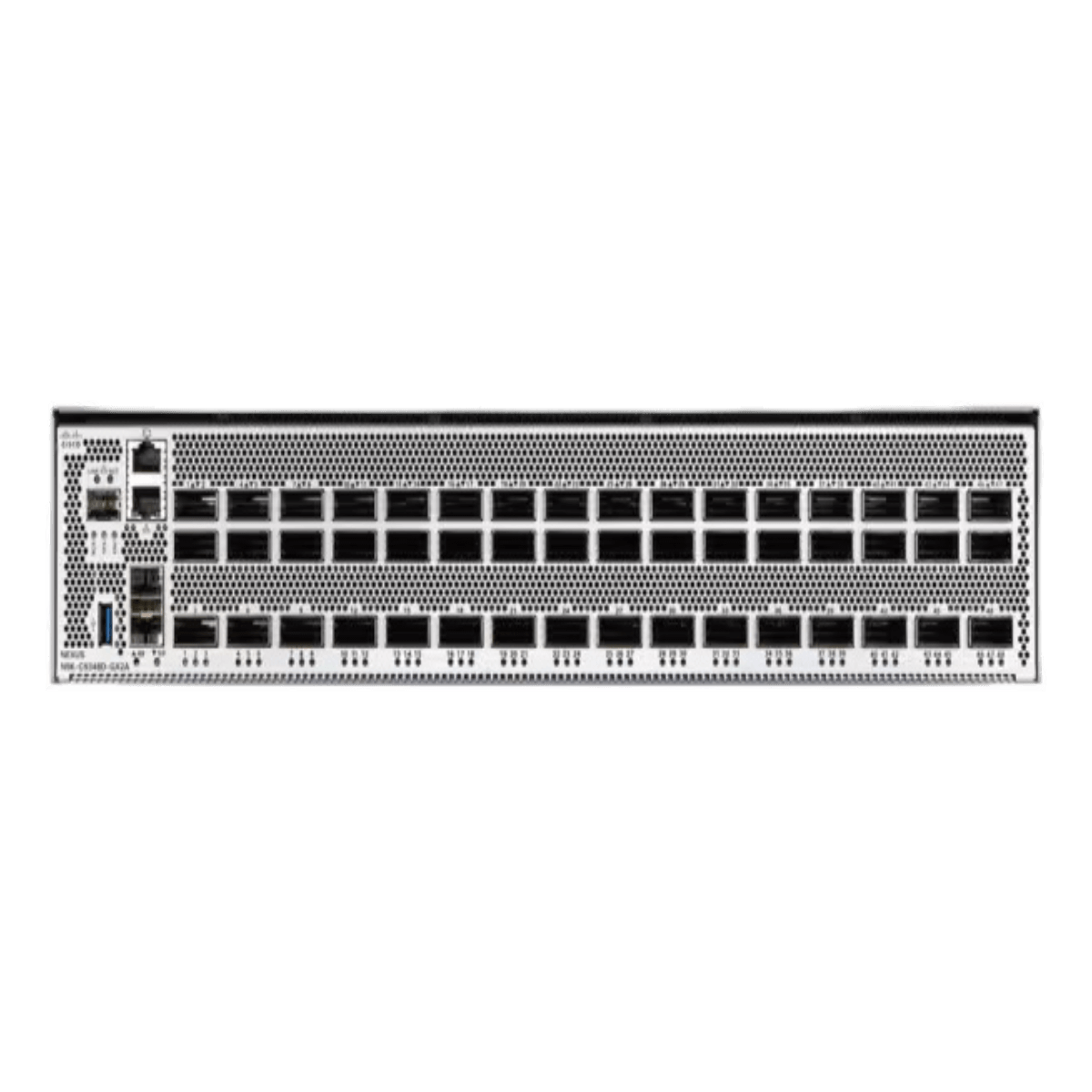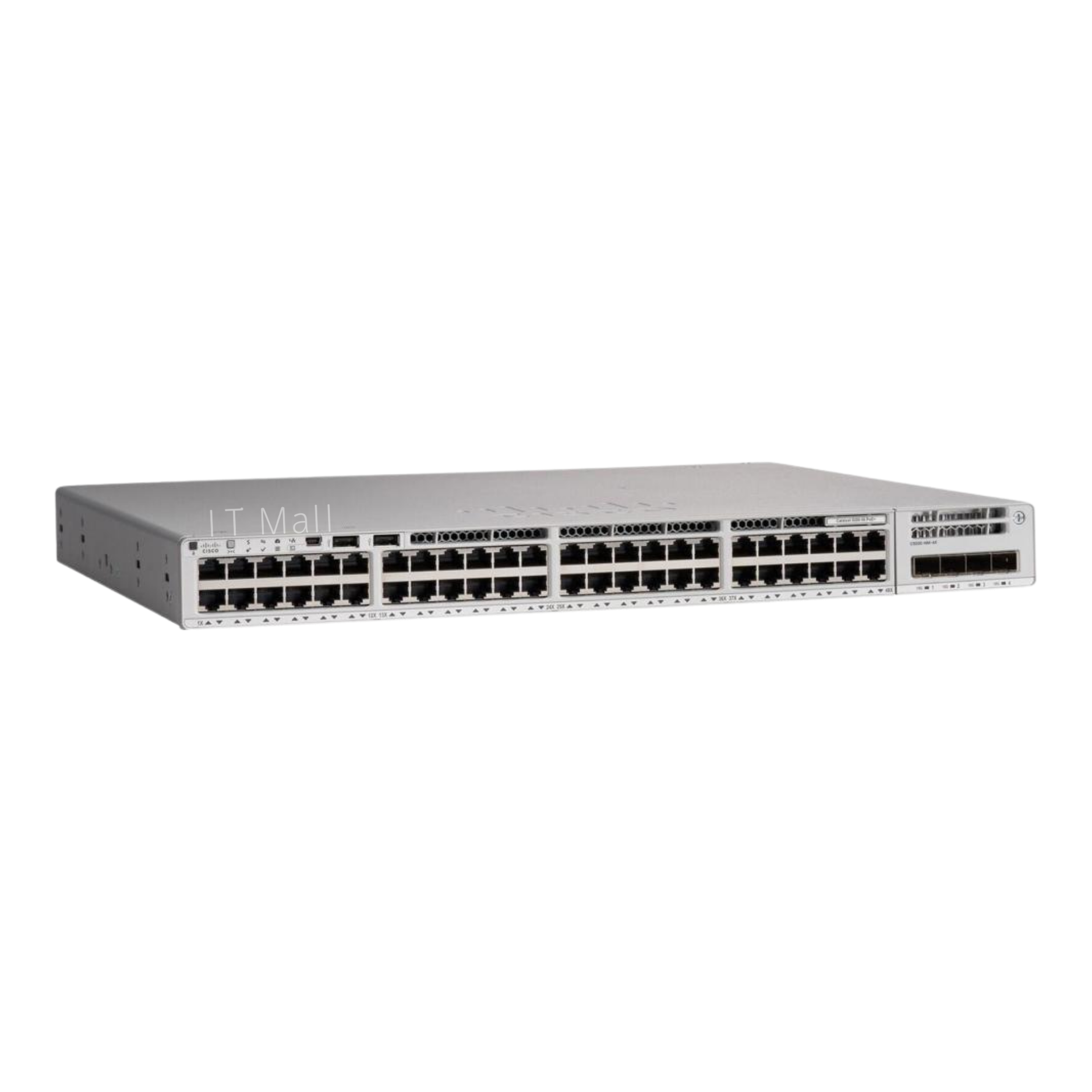Cisco Nexus 9348D-GX2A Switch with 48p 400/100-Gbps QSFP-DD ports and 2p 1/10 SFP+ ports
Condition: NOB
RMA Warranty
Description
Product brief
The Cisco Nexus 9348D-GX2A is a compact 2RU switch that supports 48 fixed 400G QSFP-DD ports and two fixed 1/10G SFP+ ports with a bandwidth of 38.4 Tbps at 8.35 bpps (Figure 1).The QSFP-DD ports also support native 200G (QSFP56), 100G (QSFP28) and 40G (QSFP+). Each port can also support 4x10G, 4x25G, 4x50G, 4x100G and 2x200G branches.
Figure 1
Features and benefits
Architectural flexibility
The Cisco Nexus 9000 Series switches utilize a comprehensive set of unicast and multicast IPv6/IPv4 and Ethernet protocols to support various features, including Cisco Application Centric Infrastructure (Cisco ACI), Cisco NX-OS VXLAN EVPN, Cisco IP Fabric for Media, Cisco Nexus Dashboard Data Broker, and IP routing or Ethernet switching in Layer 2 fabrics.
- The Cisco NX-OS Software operating system is purpose-built, featuring comprehensive and proven innovations. It follows a modular design, with a dedicated process for each routing protocol. This approach isolates faults while enhancing availability.
- The Cisco offers an industry-leading Software-Defined Networking (SDN) solution with support for Cisco ACI. Cisco ACI is a holistic, intent-driven architecture that centralizes automation and utilizes policy-based application profiles.
- Cisco Nexus 9000 Series switches provide support for standards-based VXLAN EVPN fabrics, including hierarchical multisite capabilities. For more detailed information, you can refer to the VXLAN network with MP-BGP EVPN control plane.
- These switches utilize three-tier BGP architectures, allowing the creation of horizontal, nonblocking IPv6 network fabrics at web scale.
- The Cisco Nexus 9000 Series switches offer comprehensive protocol support for Layer-3 (both IPv4 and IPv6) unicast and multicast routing. These protocols include BGP (Border Gateway Protocol), OSPF (Open Shortest Path First), EIGRP (Enhanced Interior Gateway Routing Protocol), RIPv2 (Routing Information Protocol Version 2), PIM-SM (Protocol Independent Multicast Sparse Mode), SSM (Source-Specific Multicast), and MSDP (Multicast Source Discovery Protocol).
- Segment routing (SR and SRv6) enables networks to forward multiprotocol label switching (MPLS) packets and perform traffic engineering without relying on Resource Reservation Protocol (RSVP) Traffic Engineering (TE). It offers a control-plane alternative that enhances network scalability and virtualization.
- Cisco IP Fabric for Media facilitates the transition from an SDI (Serial Digital Interface) router to an IP-based infrastructure. In this IP-based setup, a single cable can handle multiple bidirectional traffic flows, accommodating different flow sizes without necessitating changes to the physical infrastructure.
- Nexus Dashboard Data Broker offers customers comprehensive network observability. It helps identify and mitigate security threats, address performance bottlenecks, ensure data compliance, and provides insights for capacity planning operations.
Extensive programmability
- Day-0 Automation: Achieved through Power-On Auto Provisioning (POAP), significantly reducing provisioning time.
- DevOps Integrations: Industry-leading support for DevOps configuration management tools like Ansible. Extensive native YANG and industry-standard OpenConfig model support via RESTCONF, NETCONF, and gNMI.
- REST API with DME: Interaction facilitated through REST API with the Data Management Engine.
- Model-Driven Telemetry: Enhances network observability.
- Third-Party Application Hosting: Utilize Cisco Application Framework (CAF) for hosting third-party applications.
High scalability, flexibility, and security
- Flexible Forwarding Tables: Supported on Cisco Nexus 9300-GX2 models, accommodating up to two million shared entries.
- IEEE 802.1ae MAC Security (MACsec): Available on selected ports of 9300-GX2 models, enabling traffic encryption at the physical layer. It ensures secure connectivity for servers, border leaf, and leaf-to-spine connections.
AI/ML networking
Cisco Nexus 9300 GX2 Series Fixed Switches incorporate advanced congestion management and flow control algorithms, optimized latency, and robust telemetry capabilities to meet the specific design needs of AI/ML fabrics.
- Priority Flow Control (PFC) is a critical feature supported on Cisco Nexus 9000 Series Switches. It prevents Ethernet frame drops by signaling, controlling, and managing Ethernet flows along the path, achieved by sending pause frames to the appropriate senders.
- The platform also supports Explicit Congestion Notification (ECN), which provides end-to-end notification per IP flow by marking packets that have experienced congestion, without dropping traffic. The platform can track ECN statistics, including the number of marked packets that encountered congestion.
- The platform provides lossless transport for Remote Direct Memory Access (RDMA) over Converged Ethernet (RoCE) through support for Data Center Bridging (DCB) protocols.
- Enhanced Transmission Selection (ETS): Reserves bandwidth per priority class during network contention.
- Data Center Bridging Exchange Protocol (DCBX): Discovers and exchanges priority and bandwidth information with endpoints.
- Weighted Random Early Detection (WRED): This congestion-avoidance technique enables Cisco Nexus 9000 Series Switches to detect and respond to network congestion by marking flows that might contribute to congestion.
- The platform features Cisco’s intelligent buffer management, which distinguishes between “mice” (smaller) and “elephant” (larger) flows. It applies different queue-management strategies based on their network forwarding needs when link congestion occurs.
- Approximate Fair Dropping (AFD) with Elephant Trap (ETRAP): By utilizing ETRAP, AFD distinguishes long-lived elephant flows from short-lived mice flows. ETRAP monitors incoming flow byte counts and compares them to a user-defined threshold. Once a flow exceeds the threshold, it is classified as an elephant flow.
- Dynamic Packet Prioritization (DPP): This feature separates mice flows and elephant flows into distinct queues, allowing independent allocation of buffer space for each type of flow.
Hardware and software high availability
- Virtual Port-Channel (vPC) technology enables Layer-2 multipathing by eliminating the need for Spanning Tree Protocol (STP).
- Fabric Link in VXLAN Environment: Eliminates the requirement for peer-to-peer vPC. The 128-way Equal-Cost Multipath (ECMP) routing allows Layer-3 fat-tree designs, enhancing network scalability and resilience while minimizing disruptions.
- Software Maintenance Upgrade (SMU): Provides targeted fixes for specific defects, ensuring rapid resolution of critical issues.
- In-Service Software Upgrades (ISSU): Allows software upgrades without disrupting traffic flow, reducing or eliminating downtime.
- Hot-Swappable Components: The switches feature N+1 redundant Power-Supply Units (PSUs) and fans.
Cisco Nexus Dashboard
- Cisco Nexus Dashboard Overview:
Cisco Nexus Dashboard is a powerful platform that simplifies data center and cloud network operations. It achieves this through automation, analytics, and seamless integration of various services. These services include Cisco Nexus Dashboard Fabric Controller (NDFC), Cisco Nexus Dashboard Insights (NDI), Cisco Nexus Dashboard Orchestrator (NDO), and Cisco Nexus Dashboard Data Broker (NDDB). By providing a unified interface and consolidated management capabilities, Cisco Nexus Dashboard enhances network visibility, efficiency, and overall operational agility.
- Licensing Details:
- Cisco Nexus Dashboard comes bundled with all Cisco Nexus 9000 switch tiered licenses.
- To utilize Cisco Nexus Dashboard Fabric Controller, you’ll need the Cisco Data Center Networking (DCN) Essentials license.
- For Cisco Nexus Dashboard Orchestrator, the Cisco DCN Advantage license is required.
- Finally, Cisco Nexus Dashboard Insights relies on either the Cisco DCN Premier license or the Cisco DCN Day-2 Ops add-on license.
Specifications
Table 1. Physical Specifications
| Physical Specifications | |
|---|---|
| Ports | 48-port 400G QSFP-DD and 2-port 1/10G SFP+ |
| Buffer | 120MB |
| System Memory | 32 GB |
| SSD | 128GB |
| USB Ports | 1 |
| RS-232 Serial Console Ports | 1 |
| Management Ports | 2 (1 x 10/100/1000BASE-T and 1 x 1-Gbps SFP) |
| CPU | 6cores |
Table 2. Power and Cooling
| Power and Cooling | |
|---|---|
| Power | 3200W AC |
| Input Voltage | 100 to 240V AC |
| Fans | Hot-swappable, 4fans, 3+1 redundancy |
| Frequency | 50 to 60 Hz (AC) |
| Efficiency | 90% or greater (20 to 100% load) |
| Airflow | Port-side intake |
| Typical Power | 1380W |
| Maximum Power | 3124W |
Table 3. Environmental Specifications
| Environmental Specifications | |
|---|---|
| Physical Dimensions (H x W x D) | 3.45 x17.41 x 29.83 in.(8.76 x 44.23 x 75.76 cm) |
| Acoustics | 71.9dBA at 50% fan speed, 87.6 dBA at 70% fan speed, and 96.4 dBA at 100% fan speed |
| Operating Temperature | 32 to 104°F (0 to 40°C) |
| Nonoperating (Storage) Temperature | –40 to 158°F (–40 to 70°C) |
| Humidity | 5 to 85% (noncondensing) |
| Altitude | 0 to 13,123 ft (0 to 4000m) |
| MTBF (Mean Time Between Failure) | 125,780 hours |
Table 4. Performance and scalability specifications
| Item | |
|---|---|
| Number of slices | 4slice-pairs |
| Maximum number of IPv4 Longest Prefix Match (LPM) routes* | 1Million |
| Maximum number of IPv4 host entries* | 1Million |
| Maximum number of IPv6 Longest Prefix Match (LPM) routes* | 500k |
| Maximum number of IPv6 host entries* | 1Million |
| Maximum number of MAC address entries* | 500k |
| Maximum number of multicast routes | 256,000 |
| Number of Internet Group Management Protocol (IGMP) snooping groups | Maximum: 32,000 |
| Maximum number of Access-Control-List (ACL) entries | 6000 ingress/slice
3000 egress/slice (Max: 48,000 ingress, 24,000 egress) |
| Maximum number of VLANs | 4096** |
| Number of Virtual Routing and Forwarding (VRF) instances | Maximum: 16,000 |
| Maximum number of ECMP paths | 64 |
| Maximum number of port channels* | 512 |
| Maximum number of links in a port channel* | 32 |
| Number of active SPAN sessions | 32 (4 Active) |
| Maximum number of VLANs in Rapid per-VLAN Spanning Tree (RPVST) instances | 4K |
| Maximum number of Hot-Standby Router Protocol (HSRP) groups | 1000 |
| Maximum number of Multiple Spanning Tree (MST) instances | 64 |
| Flow-table size | 128K/slice |
| Number of Network Address Translation (NAT) entries | 2000 |
| Number of Output Queues | 8 |
| Component | Weight |
|---|---|
| Cisco Nexus 9348D-GX2A (without power supplies or fans) | 51.2 lb (23.2 kg) |
| NXA-PAC-1500W-PI | 2.64 lbs (1.2 kg) |
| NXA-PAC-3200W-PI | 3.66 lbs (1.66 kg) |
| NXASFAN-160CFM2PI | 1.3 lbs (0.6 kg) |
| NXA-SFAN-35CFM-PI | 0.26 lbs (0.1 kg) |
Ordering information
Table 6. Ordering information
|
Part number |
Product description |
|
Hardware |
|
| N9K-C9348D-GX2A |
Cisco Nexus 9348D-GX2A Switch with 48p 400/100-Gbps QSFP-DD ports and 2p 1/10 SFP+ ports |
|
FAN options |
|
|
NXASFAN-160CFM2PI |
Cisco Nexus Fan, 160CFM, port-side intake airflow |
|
NXA-SFAN-35CFM-PI |
Cisco Nexus Fan, 35CFM, port-side intake airflow |
|
Power supply options |
|
|
NXA-PAC-3200W-PI |
Cisco Nexus 3200W AC PS, port-side intake |
|
NXA-PAC-1500W-PI |
Cisco Nexus 1500W AC PS, port-side intake |
|
NXA-PAC-1500W-PE |
Cisco Nexus 1500W AC PS, port-side exhaust |
|
Power cords |
|
|
NO-PWR-CORD |
No Power Cord Chosen |
|
CAB-C15-CBN-EURA |
Cabinet Jumper Power Cord, 250 VAC 13A, C14-C15 Connectors |
|
CAB-C15-CBN-CK |
Cabinet Jumper Power Cord, 250 VAC 10A, C14-C15 Connectors |
|
CAB-C15-CBN |
Cabinet Jumper Power Cord, 250 VAC 13A, C14-C15 Connectors |
|
CAB-PWR-C15-CHN-A |
Power Cord,C15,Black,2.5m,10A,China |
|
CAB-HVDC-3T-2M |
HVDC power cable, China CCC Compliant, thin, 2 meters |
| CAB-HVAC-C14-2M |
HVAC power cable for C14, 2 meters |
|
CAB-HVAC-RT-0.6M |
HVAC Power cable with right angle connector for RF-LS-25 |
|
CAB-HVAC-SD-0.6M |
HVAC Power cable for Anderson-LS-25 |







Zane (verified owner) –
Good service.
Edward (verified owner) –
Very fast delivery.